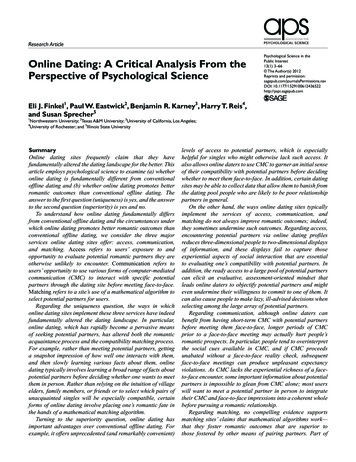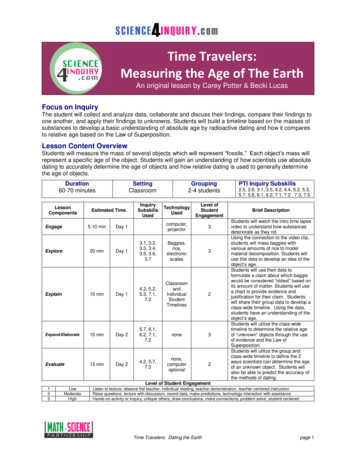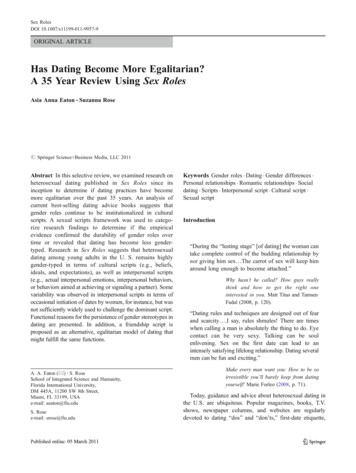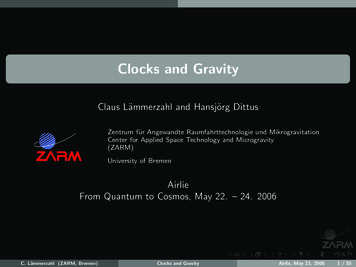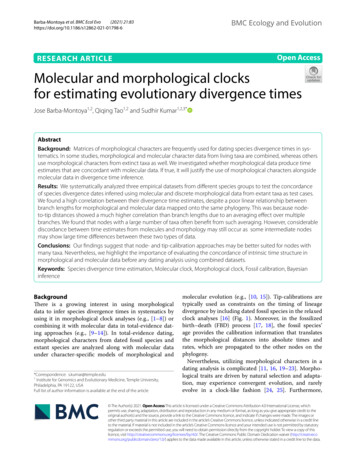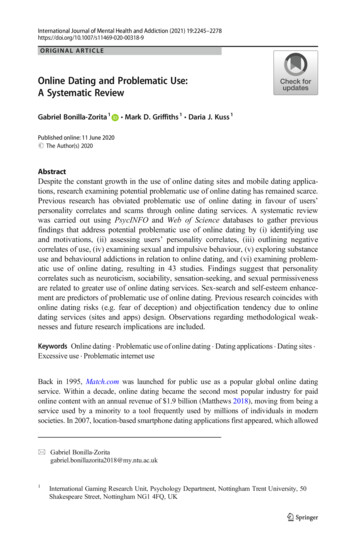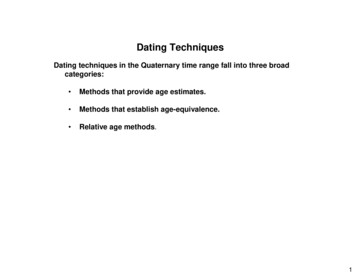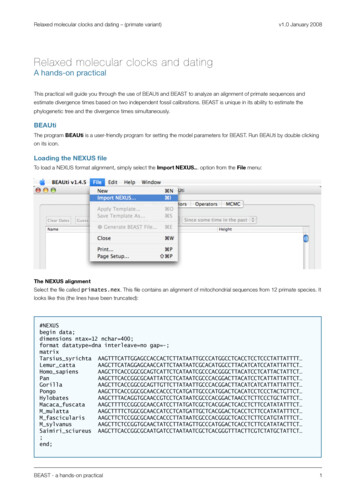
Transcription
Relaxed molecular clocks and dating – (primate variant)v1.0 January 2008Relaxed molecular clocks and datingA hands-on practicalThis practical will guide you through the use of BEAUti and BEAST to analyze an alignment of primate sequences andestimate divergence times based on two independent fossil calibrations. BEAST is unique in its ability to estimate thephylogenetic tree and the divergence times simultaneously.BEAUtiThe program BEAUti is a user-friendly program for setting the model parameters for BEAST. Run BEAUti by double clickingon its icon.Loading the NEXUS fileTo load a NEXUS format alignment, simply select the Import NEXUS. option from the File menu:The NEXUS alignmentSelect the file called primates.nex. This file contains an alignment of mitochondrial sequences from 12 primate species. Itlooks like this (the lines have been truncated):#NEXUSbegin data;dimensions ntax 12 nchar 400;format datatype dna interleave no gap -;matrixTarsius syrichta CCCTATTATTTT Lemur ATCATCCATATTATTCT Homo ACATCCTCATTACTATTCT CCTCATTATTATTCT ACATCATCATTATTATTCT ATCCTCCCTACTGTTCT TAACCTCTTCCCTGCTATTCT Macaca ACCTCTTCCATATATTTCT M ACCTCTTCCATATATTTCT M GGCTCACCTCTTCCATGTATTTCT M CACCTCTTCCATATACTTCT Saimiri sciureus CTATGCTATTCT ;end;BEAST - a hands-on practical1
Relaxed molecular clocks and dating – (primate variant)v1.0 January 2008Once loaded, the list of taxa and the actual alignment will be displayed in the main panel:Defining the calibration nodesSelect the Taxa tab at the top of the main window. You will see the panel that allows you to create sets of taxa that willenable you to put calibration information for each of their most recent common ancestors (MRCAs). Press the small “plus”button at the bottom left of the panel:This will create a new taxon set. Rename it by double-clicking on the entry that appears (it will initially be called untitled1).Call it ingroup (it will contain all taxa except the lemur, which will form the outgroup). In the next table along you will see theavailable taxa. Select all taxa and press the green arrow button. Move the lemur back into the excluded taxa set. Since weknow that lemur is the outgroup, we will set select the checkbox in the Monophyletic? column. This will ensure that theingroup is kept monophyletic during the course of the MCMC analysis.BEAST - a hands-on practical2
Relaxed molecular clocks and dating – (primate variant)v1.0 January 2008Now repeat the whole procedure creating a set called H-C that contains on the human and chimp. The screen should looklike this:Finally, create a taxon group that contains everything under the hominoid/cercopithecoid split (i.e. everything except Lemur,Saimiri and Tarsius). Call this taxon set something like HomiCerco.Setting the evolutionary modelThe next thing to do is to click on the Model tab at the top of the main window. This will reveal the evolutionary modelsettings for BEAST. Exactly which options appear depend on whether the data are nucleotides or amino acids (ornucleotides translated into amino acids). The settings that will appear after loading the Primate data set will be as follows:BEAST - a hands-on practical3
Relaxed molecular clocks and dating – (primate variant)v1.0 January 2008Most of the models should be familiar to you. For this analysis, we will make two changes. First you need to turn off the Fixmean substitution rate option. This is because we wish to estimate the mean substitution rate (and in doing so thedivergence times). Ignore the warning that appears. The second thing we will do is to change the molecular clock model toRelaxed Clock: Uncorrelated Log-normal so as to account for lineage-specific rate heterogeneity.PriorsThe next tab allows priors to be specified for each parameter in the model. The first thing to do is to specify that we wish touse a Yule process as the tree prior. This is a simple model of speciation that is more appropriate when consideringsequences from different species. Select this from the menu:We now need to specify a distribution for the divergence of humans and chimpanzees based on our prior fossil knowledge.This is known as calibrating our tree. We will actually use multiple calibrations in this analysis; one on the human-chimp splitand one on the hominoid-cercopithecoid split. Click on the button in the table next to tmrca(H-C):A dialog box will appear allowing you to specify a prior for this MRCA. Select the Normal distribution:BEAST - a hands-on practical4
Relaxed molecular clocks and dating – (primate variant)v1.0 January 2008We are going to assume a normal distribution centered at 6 million years with a standard deviation of 0.5 million years. Thiswill give a central 95% range of about 5-7.Following the same procedure set a calibration of 24 million years /- 0.5 million (stdev) for the hominoid-cercopithecoidsplit.Setting the MCMC optionsIgnore the Operators tab as this just contains technical settings for the MCMC program. The next tab, MCMC, providessettings to control the MCMC:Firstly we have the Length of chain. This is the number of steps the MCMC will make in the chain before finishing. Howlong this should be depends on the size of the data set, the complexity of the model and the quality of answer required. Thedefault value of 10,000,000 is entirely arbitrary and should be adjusted according to the size of your data set.For this data set let's initially set the chain length to 2,000,000 as this will run reasonably quickly on most modern computers(a few minutes).The next options specify how often the current parameter values should be displayed on the screen and recorded in the logfile. The screen output is simply for monitoring the programs progress so can be set to any value (although if set too small,the sheer quantity of information being displayed on the screen will actually slow the program down). For the log file, thevalue should be set relative to the total length of the chain. Sampling too often will result in very large files with little extrabenefit in terms of the precision of the analysis. Sample too infrequently and the log file will not contain much informationabout the distributions of the parameters.Set the screen log to 10000 and the file log to 200.The final two options give the file names of the log files for the parameters and the trees. These will be set to a default basedon the name of the imported NEXUS file. If you are using Windows, we suggest you add the suffix .txt to both of these (so, Primates.log.txt andPrimates.trees.txt) so that Windows recognizes these as text files.BEAST - a hands-on practical5
Relaxed molecular clocks and dating – (primate variant)v1.0 January 2008Generating the BEAST XML fileWe are now ready to create the BEAST XML file. Select Generate BEAST File. from the File menu and save the file withan appropriate name (we usually end the filename with '.xml'). We are now ready to run the file through BEAST.Running BEASTNow run BEAST and when it asks for an input file, provide your newly created XML file as input. BEAST will then run until ithas finished reporting information to the screen. The actual results files are save to the disk in the same location as yourinput file and will look something like this:BEAST v1.4.7, 2002-2008Bayesian Evolutionary Analysis Sampling TreesbyAlexei J. Drummond and Andrew RambautDepartment of Computer ScienceUniversity of Aucklandalexei@cs.auckland.ac.nzInstitute of Evolutionary BiologyUniversity of Edinburgha.rambaut@ed.ac.ukDownloads, Help & Resources:http://beast.bio.ed.ac.uk/Source code distributed under the GNU Lesser General Public onal programming & components created by:Roald ForsbergGerton LunterSidney MarkowitzOliver PybusThanks to (for use of their code):Korbinian StrimmerRandom number seed: 1185907250052MacRomanParsing XML file: primates.xmlRead alignment, 'alignment':Sequences 12Sites 400Datatype nucleotideSite patterns 'patterns' created from positions 1-400 of alignment 'alignment'pattern count 199Creating the tree model, 'treeModel'initial tree topology (((((((Gorilla,M mulatta),M fascicularis),Macaca fuscata),((Hylobates,M sylvanus),Pongo)),(Homo sapiens,Pan)),(Saimiri sciureus,Tarsius syrichta)),Lemur catta)Using discretized relaxed clock model.parametric model logNormalDistributionModelrate categories 22Creating state frequencies model: Using emprical frequencies from data {0.3060,0.3294, 0.1079, 0.2567}Creating HKY substitution model. Initial kappa 1.0Creating site model.BEAST - a hands-on practical6
Relaxed molecular clocks and dating – (primate variant)v1.0 January 2008TreeLikelihood using native nucleotide likelihood coreIgnoring ambiguities in tree likelihood.Partial likelihood scaling off.Branch rate model used: discretizedBranchRatesCreating swap operator for parameter branchRates.categories (weight 30)Creating the MCMC chain:chainLength 1000000autoOptimize truefullEvaluation 2000Pre-burnin (10000 states)0255075100 -------------- -------------- -------------- -------------- ***********state PosteriorPrior0-2,735.7205-59.145110000 123Root Operator analysisOperatorPr(accept) Performance ucld.stdev0.4560.2825up:ucld.mean y settingscaleFactor to about 0.8760swapOperator(branchRates.categories)0.4417No 2739subtreeSlide3.8750.3005Try increasing size to about4.976102428519987Narrow Exchange0.0031Wide Exchange0.0004wilsonBalding0.0002BEAST - a hands-on practical7
Relaxed molecular clocks and dating – (primate variant)v1.0 January 2008Analysing the resultsRun the program called Tracer that you will find in the BEAST package. When the main window has opened, chooseImport Trace File from the File menu and select the file that BEAST has created called primates.log. You should nowsee the following:On the left hand side is a list of the different parameters and statistics that BEAST has logged. Select meanRate to look atthe rate of evolution and treeModel.rootHeight to look at the marginal posterior distribution of the age of the root ofthe whole tree. Tracer will plot a distribution for the selected parameter and also give you statistics about each such as themean. The 95% HPD stands for highest posterior density interval and is the equivalent of confidence intervals. In particular itis the shortest interval that contains 95% of the probability for the selected quantity.How old is the root of the tree (give the mean and the HPD range)?How fast does this gene fragment evolve in apes?What sources of error does this estimate include?Is the rate of evolution significantly different on different lineages?BEAST - a hands-on practical8
Relaxed molecular clocks and dating – (primate variant)v1.0 January 2008Obtaining a treeJust like BEAST produces a sample of parameter estimates that need to be summarized, it also produces a sample ofplausible trees. These need to be summarized using the program TreeAnnotator. This will take the set of trees and find thebest supported one. It will then annotate this summary tree with the mean ages of all the nodes and the HPD ranges. It willalso calculate the posterior clade probability for each node. Run the TreeAnnotator program and set it up to look like this:For the input file, select the trees file that BEAST created (by default this will be called primates.trees) and select a filefor the output (here I called it primates summary.tree. The burnin will mean it ignores the first 1000 trees (out of atotal of 10000). Choose Mean heights for node heights. Now press Run and wait for the program to finish.Finally, we can look at the tree in another program called FigTree. Run this program, and open theprimates summary.tree file by using the Open command in the File menu. The tree should appear. You can now tryselecting some of the options in the control panel on the left. Try selecting Node Bars to get node age error bars. Also turnon Branch Labels and select posterior to get it to display the posterior probability for each node. Under Appearanceyou can also tell FigTree to colour the branches by the rate.You should end up with something like this:BEAST - a hands-on practical9
Relaxed molecular clocks and dating – (primate variant)v1.0 January 2008QuestionsWhat is the posterior probability of hominoid-cercopithecoid monophyly?What is the marginal posterior estimate and HPD for the Human-Pongo split?BEAST - a hands-on practical10
Relaxed molecular clocks and dating – (primate variant)v1.0 January 2008Advanced Exercises (optional)Open the BEAST XML file in a text editor and find the patterns element in the XML file. It should look like this: patterns id "patterns" from "1" alignment idref "alignment"/ /patterns Add an attribute called “to” with value “200” like so: patterns id "patterns" from "1" to "200" alignment idref "alignment"/ /patterns Re-running the analysis will now only consider the first 200 sites. How do the posterior clade probabilities change? How dothe divergence time estimates change?Comparing your results to the priorUsing BEAUti set up the same analysis but under the MCMC options, select the Sample from prior only option:This will allow you to visualize the full prior distribution in the absence of your data. Summarize the trees from the full priordistribution and compare the summary to the posterior summary tree.What are the main ways in which the prior distribution on trees differs from the posterior distribution?Are there any surprises?Check out http://beast.bio.ed.ac.uk/ for more tutorials and an introduction to XML and the BEAST input file. TheManual also has some useful material.BEAST - a hands-on practical11
Relaxed molecular clocks and dating A hands-on practical This practical will guide you through the use of BEAUti and BEAST to analyze an alignment of primate sequences and estimate divergence times based on two independent fossil calibrations. BEAST is unique in its ability to estimate the p
